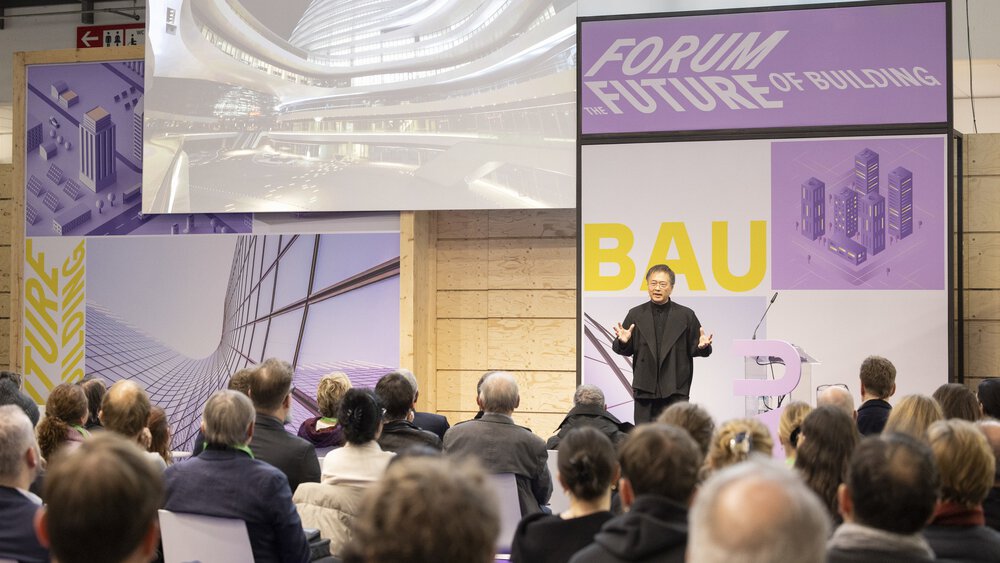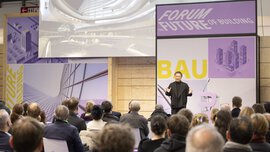The New World—Zaha Hadid Architects
Five days full of inspiration, innovation and expertise: BAU 2025 was not only an impressive trade fair, but also inspired visitors with a first-class supporting programme—over 200 presentations on various stages offered exciting insights into the future of construction.
A highlight of the supporting programme was the presentation by the renowned London-based architecture firm Zaha Hadid Architects (ZHA). In an eagerly awaited presentation, Satoshi Ohashi, Director of ZHA China, provided fascinating insights into current projects and the digital future of construction. The lecture was one of the best-attended programme items at the trade fair and showed how architecture, innovation and technology are inextricably interwoven at ZHA.
Architecture meets the digital future
ZHA is one of the most influential architecture firms of our time - known for its sculptural, dynamic and often futuristic buildings. Founded by Pritzker Prize winner Zaha Hadid, who died in 2016, the firm continues her radical understanding of design in the digital present. With over 400 employees worldwide, ZHA combines avant-garde design with technological innovation. In his lecture, Satoshi Ohashi covered everything from ZHA's characteristic design language to specific technologies such as AI-supported design, algorithmic planning and 3D-printed structures. The audience not only gained an insight into the design culture of one of the world's most visionary architecture firms—but also into a future in which design, technology and sustainability are increasingly merging.

A look back
In his presentation, Satoshi Ohashi painted an impressive picture of ZHA's development: from a small studio without computers in the late 1980s to a world-leading architecture firm with its own digital technologies. ‘We painted and imagined the future’, Ohashi recalls. This imagination—coupled with the conviction that anything is possible—is still part of the firm's DNA today. ZHA is always inspired by natural processes: the flow of water, urban movements or the relationships between things. Over the years, this attitude has given rise to its own tools and technologies—powerful digital systems that enable ZHA to analyse complex urban contexts and design new types of buildings. The projects presented are not dreams of the future, but next-generation architecture that has already been realised or is currently under construction.
—and forward
The way in which ZHA thinks and designs architecture is crucial: technology-driven, research-based and deeply human. At the centre of this is the realisation that architecture today is no longer just built, but increasingly also programmed and simulated. The in-house research department ZHA CODE, headed by Shajay Bhooshan, is developing its own design tools, algorithms and digital workflows for this purpose. ‘We build systems that open up new possibilities,’ says Bhooshan, describing this approach—for example through AI-supported design, flow simulation or robot-assisted production.










Research, AI and spaces for life
In his presentation, Ohashi emphasised that innovation and intelligence are the foundation of all projects. ZHA has created a digital system that connects people with the network of buildings, cities, experiences and natural processes. Architecture is understood as a learning, iterative process: Big ideas—and real buildings—emerge from small research steps. Specialists work in specially formed teams on topics such as programming, social spatial perception, materials research and AI. This is not about technology as an end in itself, but about the central question: How can we live and work better? A central goal is to better understand human behaviour—and thus design functional spaces that can be experienced by the senses. The internal ‘Social’ team at ZHA analyses how people move around in spaces, how decisions are made—and how productive, pleasant environments can be created as a result. At the same time, ecological aspects are incorporated into the design process at an early stage. Whether zero-energy buildings in the desert or façades made from recycled materials—every project starts by analysing the climate, sun patterns, wind conditions and material cycles. With the help of digital simulation tools, this results in an intelligent, site-specific design. One example of this digital way of thinking is ZSPACE, a platform developed jointly with NVIDIA that combines AI, simulation and production in an end-to-end real-time workflow. Here, architecture becomes a networked, digital system that can continuously evolve—just like the cities for which it is built.
More than just a lecture
Satoshi Ohashi's lecture was an impressive plea for an architecture that understands technology not as a tool, but as a way of thinking. Architecture is created where data, material and human experience come together. If you want to know exactly what this looks like—and why it is worth rethinking design—you should take a look at the recording.
Watch it now: The recording of ‘The New World—Zaha Hadid Architects’ shows what the digital transformation of design looks like in concrete terms - and why it affects us all.
